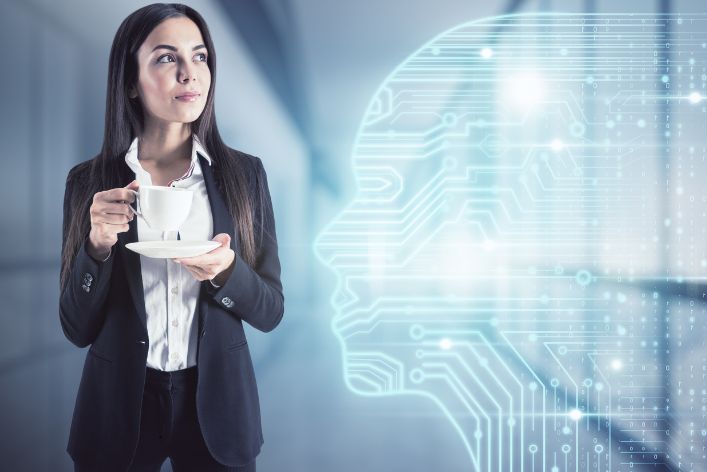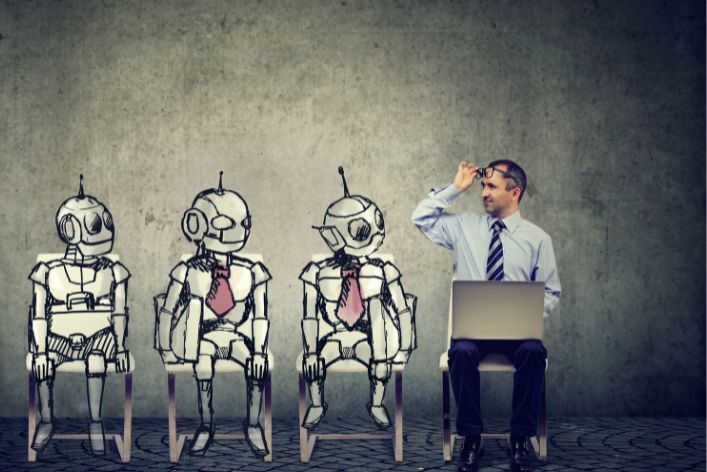Machine learning is an area of computer science that is connected to artificial intelligence.
These two technologies are the most popular ones utilized to build intelligent systems today.
Even though these two technologies are connected and occasionally used interchangeably, there are some differences.
Machine learning is only a small subset of the many topics that make up artificial intelligence.
In this context, machine learning refers to the technologies and algorithms that enable systems to identify patterns, make decisions, and improve themselves through experience and data.
Whereas artificial intelligence refers to the general ability of computers to emulate human thought and perform tasks in real-world environments.
Here, we will discuss the main variations between them.
What is Artificial Intelligence?
Artificial Intelligence is the science of creating computers and robots with to mimic and exceed human behavior.
Programs having AI capabilities can contextualize and analyze data to deliver information or automatically initiate operations without human intervention.
Many of the technologies we use today, such as smart devices and voice assistants like Siri on Apple devices, are powered by artificial intelligence.
Businesses are using methods like natural language processing and computer vision.
This allows machines to understand images and understand human language, automate jobs, speed up decision-making, and enable consumer conversations with chatbots.
Read: The Role of Artificial Intelligence in Speech Recognition Technology

What is Machine Learning?
Artificial intelligence can be attained through machine learning.
This branch of AI applies to learning to make ever-better judgements by using algorithms to automatically discover patterns and acquire insights from data.
Programmers explore the limitations of how much they can enhance a computer system’s perception, cognition, and behaviour by researching and experimenting with machine learning.
Advanced machine learning techniques like deep learning take things a step further.
Deep learning models employ huge neural networks to learn complicated patterns and anticipate outcomes without the need for human input.
Neural networks behave similarly to the human brain to rationally interpret data.
Read: The Role of Artificial Intelligence in Business
How Artificial Intelligence Works
Large data sets are combined with clever, iterative processing algorithms to create AI systems that can learn from patterns and features in the data they study.
An AI system tests and evaluates its own performance after each round of data processing in order to improve.
Because AI doesn’t require breaks, it can do hundreds, thousands, or even millions of tasks very quickly.
It can pick up a lot of knowledge quickly and excelling at whatever work it is trained to complete.
Building a computer system that can simulate human behaviour and employ human-like reasoning to solve complicated issues is the aim of AI science.
AI systems use a wide range of diverse technologies, as well as a long list of methods and procedures, to achieve this goal.
Examples of Artificial Intelligence
- Robotics. A nice illustration of AI is an industrial robot. Industrial robots are able to keep an eye on their own precision and performance, and they may feel or detect when a repair is necessary to save costly downtime. It may also act in an unfamiliar or novel setting.
- Personal Assistants. Tools for human-AI interaction such as personal assistants are another example of artificial intelligence. The most well-known personal assistants are Google Home, Cortana from Microsoft, Siri from Apple, and Alexa from Amazon.
These personal assistants give customers the ability to do a variety of tasks, including researching information, making hotel reservations, adding events to calendars, answering queries, setting up meetings, and more.
Read: Artificial Intelligence vs Deep Learning
How Machine Learning Works
Unquestionably, machine learning is one of the most fascinating divisions of artificial intelligence.
It successfully completes the goal of teaching the machine from data with specific inputs.
The first step in the machine learning process is feeding the chosen algorithm with training data.
The final machine learning algorithm is developed using training data, which might be known or unknown data.
The method is affected by the type of training data input, and that idea will be discussed in more detail shortly.
New input data is given to the machine learning algorithm to check that it functions properly.
The results and predictions are then examined.
Put Your Tech Company on the Map!
Get featured on Nicholas Idoko’s Blog for just $50. Showcase your business, boost credibility, and reach a growing audience eager for tech solutions.
Publish NowThe algorithm is repeatedly trained until the required result is discovered if the prediction does not turn out as expected.
Examples of Machine Learning
- Product Recommendations. The majority of e-commerce websites use machine learning capabilities that suggest various things based on past data. A list of books linked to machine learning will appear on Amazon’s home page. For instance, if you search for machine learning books there, browse through them, and then buy one of them. Additionally, it offers suggestions based on items you’ve liked, put in your shopping cart, and other connected actions.
- Email Spam and Malware Filtering. Spam is the term for unwanted commercial bulk emails, and it has become a major issue for internet users. To automatically learn and recognize spam emails and phishing messages, the majority of email service providers today use machine learning algorithms. For instance, the spam filters in Gmail and Yahoo mail go beyond just scanning emails for spam using pre-established algorithms. As they continue their spam filtering operations, they self-generate new rules depending on what they have discovered.
Read: Applications of Artificial Intelligence (AI)

What Makes Them So Different?
AI seeks to develop software that can imitate human intellect.
The aim of machine learning (ML), a branch of artificial intelligence, is to teach computers to learn on their own without direct programming by using historical data.
Intelligent computer systems that can tackle complex challenges like humans are the end product of AI.
Meanwhile, a machine that can be programmed to carry out a given task and produce accurate results is the end result of ML.
Deep learning and machine learning are divisions of AI. ML includes deep learning as a subcategory.
The scope of AI is relatively broad, but the scope of ML is very constrained.
Whereas AI systems strive to increase the likelihood of success, ML wants to be precise and look for patterns.
By contrasting their applications, we may compare AI and machine learning in more detail.
Things like Apple’s Siri, customer service applications, online gaming, etc. are powered by AI.
Google’s search algorithms, social media tag suggestions, and online purchasing recommendations are a few examples of how ML is used.
AI and ML deal with different kinds of data.
ML works with structured and semi-structured data, whereas AI works with structured, semi-structured, and unstructured data.
To sum up our comparison, on its own, AI reasons, learns, and self-corrects.
Only the presence of fresh data allows ML to do these tasks.
Conclusion
In conclusion, while machine learning and artificial intelligence are intertwined, they serve distinct functions in the realm of intelligent systems.
Machine learning, a subset of AI, focuses on enabling systems to learn from data and improve over time without human intervention.
In contrast, AI encompasses a broader spectrum, aiming to replicate human intelligence and reasoning across various tasks.
Understanding these differences helps appreciate the unique contributions each technology offers to advancements in smart devices, automation, and data analysis.
As both fields evolve, their collaborative potential continues to drive innovation, transforming how we interact with technology in our daily lives.
Before You Go…
Hey, thank you for reading this blog post to the end. I hope it was helpful. Let me tell you a little bit about Nicholas Idoko Technologies.
We help businesses and companies build an online presence by developing web, mobile, desktop, and blockchain applications.
We also help aspiring software developers and programmers learn the skills they need to have a successful career.
Take your first step to becoming a programming expert by joining our Learn To Code academy today!
Be sure to contact us if you need more information or have any questions! We are readily available.
[E-Books for Sale]
1,500 AI Applications for Next-Level Growth: Unleash the Potential for Wealth and Innovation
$5.38 • 1,500 AI Applications • 228 pages
Are you ready to tap into the power of Artificial Intelligence without the tech jargon and endless guesswork? This definitive e-book unlocks 1,500 real-world AI strategies that can help you.
See All 1,500 AI Applications of this E-Book
750 Lucrative Business Ideas: Your Ultimate Guide to Thriving in the U.S. Market
$49 • 750 Business Ideas • 109 pages
Unlock 750 profitable business ideas to transform your future. Discover the ultimate guide for aspiring entrepreneurs today!
See All 750 Business Ideas of this E-Book
Put Your Tech Company on the Map!
Get featured on Nicholas Idoko’s Blog for just $50. Showcase your business, boost credibility, and reach a growing audience eager for tech solutions.
Publish Now500 Cutting-Edge Tech Startup Ideas for 2024 & 2025: Innovate, Create, Dominate
$19.99 • 500 Tech Startup Ideas • 62 pages
You will get inspired with 500 innovative tech startup ideas for 2024 and 2025, complete with concise descriptions to help you kickstart your entrepreneurial journey in AI, Blockchain, IoT, Fintech, and AR/VR.
We Design & Develop Websites, Android & iOS Apps
Looking to transform your digital presence? We specialize in creating stunning websites and powerful mobile apps for Android and iOS. Let us bring your vision to life with innovative, tailored solutions!
Get Started Today



